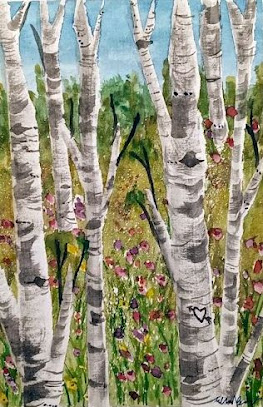For especially spectacular results, we like to include birch or aspen trees and maybe a few late-summer wildflowers using simple masking techniques.
It's so much fun (especially for beginners) to remove the masking media, finish the painting, stand back, and take a good look.
Whoa! Did I just paint that???
Next, we decide which direction to turn the paper - landscape or portrait - then we begin "painting" with tape. We rip and tear several strips of masking tape lengthwise and tape it to our watercolor paper to resemble the shapes of trees. larger strips for tree trunks and smaller ones are added as branches.
The larger trees will extend over the bottom and top borders of the paper. Smaller, thinner ones (in the distance) are placed near the center of the paper.
We use liquid masking fluid (or frisket) to dab in spots for flowers and leaves in the upper branches of the trees. We splatter on more over the lower 2/3rds or so with a toothbrush.
Now you can paint away, filling in the background behind and around the trees, painting right over the masking media as though it is not even there. We start at the bottom and work our way down. We try to mix our own colors and we don't worry if colors blend or bleed into others. That's what makes watercolors so much fun!
Once the painting is covered from top to bottom, allow it to dry, or use a blow dryer. Make sure the painting is thoroughly dry!
Complete your white "ghost" trees by adding a shadow along one side with thinned black paint. Be sure to add shadows to all tree trunks and larger branches. Next, add the characteristic black birch tree markings by scraping or painting small amounts of black and brown watercolor paint here and there on the trucks and branches.
You can also add additional thinner branches and twigs to the trees, as well as a few blades of grass at the bottom using a detail brush.
To finish, add color to your wildflowers and some fall hues to your leaves (usually bright yellow, yellow-orange, or yellow-green for birch trees and aspens), leaving the splattered areas white.
Allow the painting to dry thoroughly and remove the border tape by always keeping it flat and pulling away from the painting.
Now it's time for your "Whoa!" moment!





